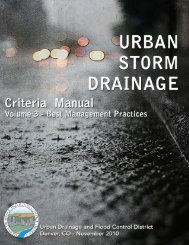Hydraulic Efficiency of Grate and Curb Inlets - Urban Drainage and ...
Hydraulic Efficiency of Grate and Curb Inlets - Urban Drainage and ...
Hydraulic Efficiency of Grate and Curb Inlets - Urban Drainage and ...
Create successful ePaper yourself
Turn your PDF publications into a flip-book with our unique Google optimized e-Paper software.
1 INTRODUCTION<br />
A research program was conducted at Colorado State University (CSU) to evaluate the<br />
hydraulic efficiency <strong>of</strong> three storm-drain inlets. <strong>Inlets</strong> tested in this study are currently used by<br />
the <strong>Urban</strong> <strong>Drainage</strong> <strong>and</strong> Flood Control District (UDFCD) <strong>of</strong> Denver, <strong>and</strong> consist <strong>of</strong> the Denver<br />
Type 13 <strong>and</strong> 16 grates, <strong>and</strong> the Colorado Department <strong>of</strong> Transportation (CDOT) Type R curb.<br />
These inlets have never been specifically studied or tested for development <strong>of</strong> hydraulic<br />
efficiency relationships. Current design practices are based upon a document produced by the<br />
Federal Highway Administration (FHWA, 2001) titled “<strong>Hydraulic</strong> Engineering Circular 22”<br />
(HEC 22). General inlet types are addressed in HEC 22, but no specific guidance is provided<br />
for these three inlets used by the UDFCD. The study presented in this report focused on<br />
collecting data on these inlets under physically-relevant design conditions, <strong>and</strong> developing<br />
improved design methods for determining inlet efficiency under varying road geometries. A 1/3<br />
Froude-scale model <strong>of</strong> a two-lane road section was designed <strong>and</strong> built at the Engineering<br />
Research Center (ERC) <strong>of</strong> CSU. The model consisted <strong>of</strong> an adjustable slope road surface, gutter<br />
panels, <strong>and</strong> three interchangeable inlet types positioned in a testing flume. Details pertaining to<br />
model construction, testing procedure, resulting database, <strong>and</strong> data analysis are presented in this<br />
report.<br />
1.1 Project Background<br />
Storm-water run<strong>of</strong>f is typically conveyed through a network comprised <strong>of</strong> streets, gutters,<br />
inlets, storm sewer pipes, <strong>and</strong> treatment facilities. Streets <strong>of</strong> developed areas <strong>of</strong>ten serve as<br />
collectors for run<strong>of</strong>f, <strong>and</strong> convey water into gutters <strong>and</strong> eventually to storm sewer inlets. Stormwater<br />
management in the metropolitan Denver area falls under the jurisdiction <strong>of</strong> the UDFCD.<br />
Policies, design procedures, <strong>and</strong> Best Management Practices (BMPs) are provided in the “<strong>Urban</strong><br />
Storm <strong>Drainage</strong> Criteria Manual” (USDCM; UDFCD, 2008). Design methods presented in the<br />
1
















